I am attempting to code a bifurcation diagram to illustrate the values of f for which the Oregonator model yields oscillatory behaviour. I get the "setting an array element with a sequence" error at the solve_ivp line. I suspect it has something to do the time span but I am not sure. I should get a Hopf bifurcation, i.e. a bullet-like cone in the region of oscillations.
Here is the code:
import numpy as np
import matplotlib.pyplot as plt
from scipy.integrate import solve_ivp
# Dimensionless constant parameters
eps = 0.04
a = 0.0008
# Dimensionless varying parameter - will reveal limit cycle region
f = np.linspace(-5,5,250)
# Oregonator model
def Oregonator(t, Y):
x,z = Y;
return [(x * (1 - x) + ((a - x) * f * z) / (a + x)) / eps, x - z]
# Time span, initial conditions
ts = np.linspace(-5, 5, 250)
Y0 = [1, 0.5]
# Numerical algorithm/method
NumSol = solve_ivp(Oregonator, [0, 30], Y0, method="Radau")
t = NumSol.t
x,z = NumSol.y
# Plot
fig = plt.figure()
ax = fig.gca(projection='3d')
ax.plot(f, x, z, 'm')
ax.set_xlabel('$f$', fontsize=10)
ax.set_ylabel('$x^*$', fontsize=10)
ax.set_zlabel('$z^*$', fontsize=10)
ax.axis([-5, 5, -5, 5])
plt.grid()
plt.show()
